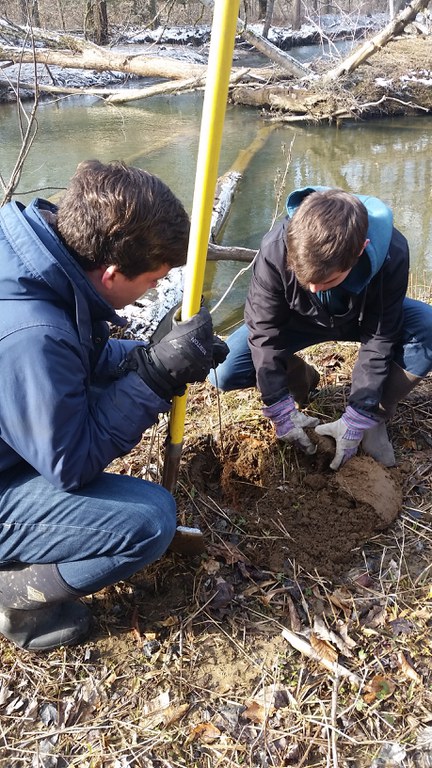Posted: July 10, 2018
On a cold April day, 40 high school students and their teacher teamed up with DCNR, NRCS, and county conservation professionals to plant over 400 saplings as part of a riparian buffer project.

This project brought together the community and state and federal agencies to help a landowner achieve a stewardship goal. (Photo by Bob Slagter, PA Forest Steward)
It's 28 degrees on April 10, but the ground is muddy under the crust. As I look down my driveway about a quarter of a mile, emerging is a group of figures marching toward my Creekhouse. That's 40 high schoolers that the bus let off to work on a Riparian Buffer Planting on my property.
I was excited about the project, as my creek needs all the help we can give it, and 435 trees would certainly be a tremendous addition to water quality improvements. But kids working on a freezing cold morning in the soggy creek bottom? Well, the prospect seemed dismal at best. After all, if you've been around teenagers, you know that their reputation for being non-communicative tweeters is legendary.
The activities began with DCNR, NRCS, County Conservation, and, most importantly, their wonderful teacher explaining to the kids exactly what was needed and precisely how it was to be done. Interjecting here, I am known by DCNR as a mass murderer of seedlings, having planted some 250 trees on my property with maybe a 10 percent success rate. If I touch a tender little sprout, it's curtains for that baby. What chance would these kids have to plant trees successfully and why would they possibly care about trees out here in the middle of nowhere?
I had a lot to learn that day about kids in the woods. First, they listened, they were attentive; they actually did seem to care. Next, they jumped into the work with a high level of energy. Could it be they welcomed the work? I'm talking digging and handling wet dirt with your hands on a frosty morning. NOBODY would want to do that, and, if they did, there would certainly be a huge helping of complaining about it.
What was it that I heard? Laughing, talking, even some singing… I was shocked! They did exactly as instructed, planted each tree with care--almost reverence--and never stopped until lunch when a dozen pizzas disappeared with an almost audible whoosh. Then after lunch, it was back to work without being asked. They completed the project by 2:30 in the afternoon, scrubbed the tools, and THANKED ME for letting them come out to my place to work.
Valuable lessons here are many, not the least of which is Teens minus Cellular Devices equals Really Cool People. And, these kids do this several times a year. If you were to add it up, the long-term good they are doing for themselves and their own future teenagers is very significant, not just in work ethic but also in physical protection of cold fresh water, something in dwindling supply and of the utmost importance.
If you are considering a planting project, contact any of the agencies mentioned above or contact me and I'll help you go in the right direction. You will help the forest, help the water, help the kids as they "Plant Their Future," and you will learn that we are leaving the world in very good hands…tomorrow has a chance because of today's kids.
James C. Finley Center for Private Forests
Address
416 Forest Resources BuildingUniversity Park, PA 16802
- Email PrivateForests@psu.edu
- Office 814-863-0401
- Fax 814-865-6275
James C. Finley Center for Private Forests
Address
416 Forest Resources BuildingUniversity Park, PA 16802
- Email PrivateForests@psu.edu
- Office 814-863-0401
- Fax 814-865-6275

